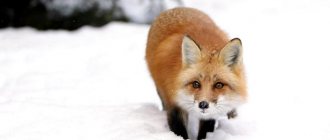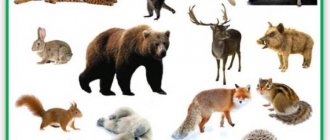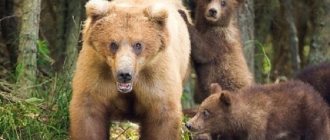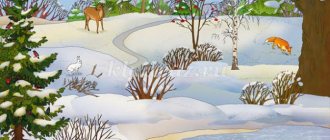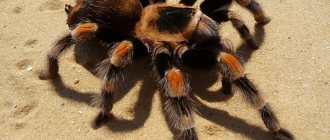Animals begin to prepare for winter during the warm season.
In the fall, squirrels can be seen carrying nuts into their hollows or burying them in the ground, only to dig them up a few months later for a winter snack.
Mice and beavers bring extra food into their homes to have food when it gets too cold, and bees store honey all summer and fall. Most mammals eat extra fat during the warm months to last through the winter. It will not only warm them during the cold season, but will also not leave them hungry.
Other animals adapt to winter weather by changing their appearance. The fur becomes thicker and heavier just as we change from an autumn jacket to a winter one. Animals such as the rabbit and the Arctic fox completely change the color of their fur, going from dark colors in summer to white in winter. This property sometimes saves their lives, because... allows them to better camouflage in the snow, making them more invisible.
Some animals are preparing for winter hibernation. For example, bears, skunks, and hedgehogs prepare cozy dens and sleep almost all winter. They enter a state of torpor, which transitions into a state of reduced physiological activity, allowing them to reduce their body temperature and metabolic rate. This allows them to survive without much food. Others, such as chipmunks, marmots, bats and even snakes, fall into an even deeper sleep, where their bodies become still for months, often not waking up until spring. This allows animals to save energy and not have to worry about food and cold for a while. They wake up hungry and often unhappy, but at least they were able to escape the worst of the weather.
Some creatures don't want to deal with winter at all! Instead, they move to places where they can easily find food and not freeze from the cold. This is called migration. Caribou and some species of deer make winter treks, as do whales and some fish, which swim long distances in search of warmer water. Even monarch butterflies fly from Canada and the United States to Mexico in search of sunnier days. In the spring, migration occurs in the opposite direction, to where winter has finally ended.
Let's look at preparing some animals for winter in more detail.
Who is first?
Nature has created separate “schedules” for various animals to organize for the winter.
Some forest dwellers begin to prudently think about cold weather not in late or early autumn (like other animals). They carry out procurement work already in the summer.
In what order do different mammals come up with the idea of preparatory activities? Rodents - wood mice, chipmunks and gophers - think about winter before others. And also boibaks (inhabitants of the “borderland” of the green area - the so-called forest-steppe). After them, fellow hamsters come into play, carrying tasty reserves in their mouths from September 1st. Squirrels (part of the same zoological community) act only at the height of Pushkin's time.
The next category of inhabitants of fragrant green thickets is the hedgehog family. They also don’t wait until the 12th month, trying to finish the important matters mentioned already in the 10th or 11th.
Only after the rest of the inhabitants of the dense tree stand do predators and the hare remember the upcoming frost and the accompanying hunger. Some are not going to work at all in winter. Better sleep.
Let's talk about how animals prepare for winter, revealing the nuances of the work of 4 zoo families.
LiveInternetLiveInternet
Quote from Tatyana57
Read in full In your quotation book or community!
Late fall. Wild animals are preparing for winter.
Children should know: - the names of wild animals in our forests: bear, wolf, elk, wild boar, badger, beaver, fox, hare, squirrel, hedgehog, lynx; - that wild animals get their own food, build their own homes; - what is the name of the home of a bear (den), wolf (den), fox (hole), squirrel (hollow); - which other animals live in minks (hares, moles, mice, gophers, hamsters); - which of the animals changes the color of their fur coat (hare, squirrel), horns (elk, deer); - distinguish between the names of body parts of animals and humans. Expanding children's vocabulary: Nouns: bear, wolf, fox, hare, hedgehog, elk, deer, wild boar, badger, lynx, squirrel, den, den, hole, hollow, wool, skin, predators; Adjectives: shaggy, shaggy, fluffy, strong, cunning, prickly, fast, dexterous, brown, toothy, clumsy, club-footed, timid, long-eared; Verbs: hunts, sneaks, howls, gets scared, jumps, waddles, cunning, tracks, stores, digs, hibernates, lies down, hibernates. Conversation “How wild animals prepare for winter.” Winter will come soon. The animals of the forest have the hardest time. They are preparing to face winter. Some animals will sleep peacefully in their houses all winter. Who is this? Bear and hedgehog. Three months is a very long time, so now these animals must eat well and accumulate a lot of fat so as not to freeze and not get hungry until spring. They insulate their houses.
- Where will the hedgehog hide? In the hole.
—Where will the bear sleep? In the den. But there are animals that do not have a house and will run through the forest all winter, looking for food.
The hare changes his summer coat to a winter one. It is not only warmer, but also a different color. - Which one? - Why white? - From whom do his long legs and white fur save the hare? From the fox and the wolf.
These are beasts of prey. If they catch a hare, it won't be good for him. The fox has a home - a hole, where she can hide from the winter cold, and the wolf has a wolf's lair. - Do foxes and wolves need to change their fur coats to new winter ones? Of course it is necessary. After all, in the summer you and I wear light clothes so that it is not hot, and in the winter we put on warmer ones, so the animals also have to change clothes. This does not mean that they take off their skins and put on new ones, they just grow different, warmer fur. This period in the life of animals is called molting.
Another small furry forest dweller who changes the color of his coat for winter. The squirrel was red all summer, but by winter it turns gray.
-Where does the squirrel live? In the hollow. -How did she prepare for winter? All summer and autumn she collected mushrooms and berries and hid them in various places. In winter, she looks for her reserves, but, unfortunately, does not always find them. But in the place where the cones or nuts were hidden, a small sprout may appear in the spring and in a few years a new tree or bush will grow here.
- But this handsome forest man wears a beautiful decoration on his head. - Who is this? Elk. —What does a moose eat? Plants. -Are there many plants in the forest in winter? There are many trees and bushes in the forest. This big beast eats their bark. Does he need much for food? A lot of. Therefore, forest rangers feed these beautiful animals so that they can survive the winter. A forester is a person who monitors the safety of the forest. Didactic exercise “One-many” (formation of plural nouns): Fox - fox. Hedgehog - hedgehog. Squirrel is protein. Hare - hares. Wolf - wolves. Elk - moose. Boar - boars. Didactic exercise “Call it affectionately” (formation of nouns with diminutive suffixes in singular and plural): Squirrel - squirrel. Fox is a fox. Hare - bunny, bunny. Squirrel is a baby squirrel. Bear is a bear cub. Wolf - wolf cub. Didactic exercise “Count to five” (coordination of nouns with numerals): One hare, two hares, three hares, four hares, five hares. One fox, ..., five foxes. One wolf, ..., five wolves. One bear, ..., five bears. One squirrel, ..., five squirrels. Didactic game “Whose? Whose? Whose? Whose?" Fox tail - fox tail. A bear's paw is a bear's paw. Wolf teeth - wolf teeth. Hedgehog needles - hedgehog needles. Whose footprint? - fox, wolf, bear, hare, squirrel. Whose ears? - fox, wolf, bear, hare, squirrel. Whose head? - fox, wolf, bear, hare, squirrel. Didactic exercise “Choose definitions”: Wolf (which one?) - gray, toothy, scary, ... Bear (which one?) - brown, club-footed, clumsy, ... Fox (which one?) - cunning, fluffy, red, ... Hedgehog (which one? ) – prickly, small, ... Hare (which one?) – long-eared, timid, cowardly, small, Didactic game “Who lives where?” (use of the nominative case of nouns): In the den lives (who?) - a bear. Living in the hole (who?) is a fox. There lives (who?) a wolf in the lair. Living in a hole (who?) is a hedgehog. In the hollow lives (who?) a squirrel. Didactic exercise “Compare animals with people.” Man has a mouth, and animals have a mouth. A person has a face, and animals have a muzzle. Humans have teeth, and animals have fangs. A person has a belly, and animals have a belly. Humans have nails, and animals have claws. Humans have hands, and animals have paws. Didactic game “Name the family” (word formation exercise):
Dad is a bear, mom is a bear, cub(s) is a bear cub(s).
The father is a wolf, the mother is a she-wolf, the cub(s) are a wolf cub(s).
The father is a fox, the mother is a fox, the cub(s) are a fox cub. Dad is a hare, mother is a hare, baby(s) is a hare(s). Didactic game “Who gives what voice?” (match the verb to the noun): The fox barks. The bear growls. The wolf howls. Hedgehog - snorts, etc. Didactic exercise “What is unnecessary and why?” Squirrel, fox, cow, wolf (cow, since the rest are wild animals). Hedgehog, bear, hare, dog (dog, since the rest are wild animals). Hare, dog, cow, cat (hare, since the rest are domestic animals). Fox, cat, hare, wolf (cat, since the rest are wild animals). Horse, bear, goat, dog (bear, since the rest are domestic animals). Game “Who will we give what?” Meat for the wolf. Raspberries - ... Honey - ... Carrots - ... Apples - ... Nuts - ... Mushrooms - ... etc. Game “Who has who?” The bear has cubs. For a fox - ... For a wolf - ... For a hare - ... For a hedgehog - ... For a squirrel - ... etc.
How squirrels and beavers prepare for winter
Squirrels live in hollows - deep voids located in tree trunks. And at a high altitude. For protection from arrogant predators. Amazingly agile owners of ears with tassels put nuts and other delicacies that they love so much there. Acorns, mushrooms and a variety of seeds are also good for nutrition.
Among the toothy ones, God awarded the beavers with the most powerful oral incisors. And so they quickly and skillfully build housing (it is always on the water - the forest itself floats into their teeth). And beavers live in large families. Therefore, they are able to build both a classic (summer) hut and winter (insulated) “apartments”. The food warehouse in the “January towns” is a pile of small branches and roots of aquatic flora. It remains to add that the dams are thoroughly strengthened closer to frost. Repairs are underway.
What is it and why do they fall into it?
Hibernation is the body’s reaction to temperature changes; in other words, it is a method of survival characterized by a decrease in body temperature and a reduction in heart rate.
Sonya the Regiment
In preparation for sleep, animals store up fat and prepare a shelter that is well protected from predators. During hibernation, an animal's body temperature can drop 10 times its normal temperature. So, for example, the temperature of a dormouse (a small rodent) drops from 38 degrees to 3.7. The heart slows down to 3 – 5 beats per minute, and in California ground squirrels it can even drop to one beat. Breathing decreases 10 times. In general, all body activity is reduced to a minimum.
Interesting: Why are the days shorter in winter (it gets dark early)? Reasons, photos and videos
Preparing hedgehogs
Animals can carry supplies for the winter directly on their backs (without using their limbs, but using needles). And the conversation, as you guessed, is about hedgehogs. Seeing “fallen” apples and high-calorie “forest meat” (mushrooms), these cunning creatures turn into a particularly prickly ball and roll over their finds. They literally pin them on their backs.
But it’s not only the food listed that hardworking hedgehogs bring to their winter nests. In the cold, they are not averse to pampering themselves with fat caterpillars, suddenly numb (at the sight of a ball rolling on them) toads and mice. You just need to collect all this yummy stuff in the fall - before it’s under the ice.
Yes, yes - a harmless-looking hedgehog is actually a predator. Then, when he sees someone smaller. By the way, it eats snakes, worms and generally anything that crawls. Many died. Take it - I don’t want it.
But that's not all. The animal is so picky in terms of comfort that it also rebuilds its housing. In order not to tremble and toss and turn in the next 3 months. Insulates the ground nest with dry leaves, makes an orthopedic mattress useful for the spine - it carries pliable but elastic forest moss.
What are the pros and cons of hibernation?
Pros: of course, reduced energy costs. Animals would not be able to survive while awake without sources of energy (i.e. food). Thus, they can spend 4-7 months sleeping using fat and nutrient reserves. Cons: decreased immunity, the possibility of dying from exhaustion and dehydration, muscle atrophy, and of course, predators have not been canceled.
Interesting: Why do animals hibernate? Description, photo and video
Naturally, animal hibernation is not studied in vain. Having the ability to isolate the chemicals that put mammals into hibernation, it would be possible to use them in surgery during certain operations.
How does a hare prepare for winter?
Some preparation of animals for winter consists only of changing the spring-summer wardrobe to a much warmer winter one. As soon as deep snow falls on the ground, it’s time for the scythe to change his clothes. By that time, the last shreds of his summer coat had already left his timid little body (our great-grandfathers dubbed this process “molting”).
But at the same time new fur grows. Dense and fluffy. Able to retain as much heat generated in the body as possible. Between its VILLS (“vols”, “lint” or “bors” - fur in old languages). However, in order for the warmth itself to be born inside the animal, it needs to eat well. In cold weather, the hare gnaws the bark of trees, because he does not know where to carry supplies (“he does not have a registration - he runs back and forth all year long”). Winter wool is a camouflage robe. White. Try to find it.
Preparing bears for cold weather
The bear, on the contrary, has already chosen housing. It will be difficult to get him out of there. Only with the help of the bark of a hunting dog or the poke of a large pike. The original Slavic-Baltic-Germanic name of the beast sounded like “ber”. He is preparing for the “white season” in November. He finds a hole, which he turns into a “log” (“log” in the original translation “place of lying”). That is why, although we already call the giant himself “honey” (“knowing about honey”), we still designate his hibernation place as “ber loga.”
Loga is a direct synonym for the word “log”; it is a natural excavation in the ground (pit). It is precisely these cavities that clubbed couch potatoes equip for their winter bedroom, lining the walls with moss, branches, leaves or dead coniferous trees (if we are talking only about the taiga). Where's the food? Already inside himself. In a state of suspended animation, the bear sucks its paw, through special pores of which fat penetrates. And it was carefully accumulated from April to October inclusive.
Finally, I would like to summarize. Some predators (wolves, foxes, lynxes) are busy hunting (and, in fact, searching for food) even in December, January and February. All preparation for the snow season, for example, for a fox, consists of changing its skin (like a hare, it changes it to a warmer one). The bear does not need food supplies (they are inside him).
Why is this happening? Predators are not afraid of anyone and create shelters only for the period of breeding. The exception is the fox, which sometimes hides in holes from specially trained hunting dogs. However, even many cowardly representatives of the fauna do not like winter shelters. The hare, for example, relies on its legs. And, on the contrary, the bear, which seems to be the most fearless, hides in a den. Not for fear of being eaten! Because of the fear of the cold, which could kill in a dream. Animals are divided into thrifty, sleeping and changing fur.
Hibernation in cold-blooded animals (snakes, frogs, lizards)
Hibernation of the American Wood Frog
The most amazing preparation for hibernation occurs in cold-blooded frogs. As the body cools, ice forms in their organs. This is very strange, because the animal can die from dehydration, or burst from the ice piercing them. However, the American wood frog does an excellent job of this: it fills its body with glycogen, which guarantees the safety of its organs. In the spring, the frog simply thaws and uses glucose (which is obtained from glycogen) into energy. But some amphibians survive the winter at the bottom of reservoirs, burrowing into or breathing through their skin.
Interesting fact: snakes, turtles, lizards and frogs can be put into hibernation on their own. You just need to lower the temperature and change the light mode.
